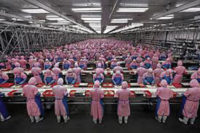The “Bangladesh Accord on Fire and Building Safety” began regular inspections in February 2014 and is scheduled to complete fire, electrical and structural integrity inspections of 1,800 garment factories by November. The public reports of these inspections, including photos of hazards like cracked columns, damaged electrical and locked fire exits, are posted on the Accord’s website, www.bangladeshaccord.org.
The Accord – agreement between two international union federations and their Bangladesh affiliates and more than 155 international clothing brands and retailers – was signed last May in the wake of the devastating collapse of the Rana Plaza building in April 2013, which killed 1,134 and injured hundreds more, and the December 2012 fire at Tazreen Fashion, which killed 112 workers.
Breaking the mold
The Accord breaks the mold of all previous post-disaster promises because the legally binding agreement requires the brands and their contract factory managers to actually change business practices in the factories producing for Accord companies, and to address some of the underlying issues that affect the two million workers in those factories.
The text of the Accord (also posted at www.bangladeshaccord.org) requires brand signatories, factory owners and the Accord’s staff to implement a comprehensive set of actions:
• the brands will provide an annual fee for the five-year tenure of the agreement, generating significant resources for Accord offices to function;
• the Accord will conduct independent inspections of all 1,800 factories with qualified Bangladeshi and international fire, electrical and structural engineers who work directly for the Accord and not the brands or factory owners;
• the Accord will publicly post inspection reports on its website with findings, photographs, required corrective actions and timelines;
• the brands must work with factory owners (some of whom are quite wealthy) to ensure the hazard corrections are completed – with the brands responsible for paying for these repairs if the factory cannot;
• the brands must work with the inspected factories and continue to source from them for two years after the initial inspection, unless the factory refuses to make the mandated corrections; and
• workers in the factories have specific rights: to participate as observers in the Accord inspections; to participate in factory health and safety committees (required by the Accord and by Bangladeshi law); to receive health and safety training; and the “right to refuse unsafe work,” both individually and collectively.
A weaker competing program
Although 14 major American clothing brands and retailers are signatories to the Accord, another 26 U.S. and Canadian brands, led by Walmart and Gap, have formed a competing “Alliance for Bangladesh Worker Safety.” The Alliance program is significantly weaker than the Accord as signatory brands are allowed to use the same inspection procedures and auditors which failed to prevent previous disasters, the inspection reports are not public, the brands are not obligated to work with factory owners to ensure hazard corrections occur, and there is near-zero participation by garment workers themselves.
Improving work conditions in the garment industry is a global challenge, perhaps more so in Bangladesh than in some other countries sourcing global garment supply chains.
Bangladesh is a very poor country with very limited occupational health and safety capacity. The government, deemed by analysts as one of the most corrupt in the world, is not accustomed to protecting garment workers. Factory owners are under constant pressure from the brands and retailers who offer an ever lower per unit price for their orders every year. Less than 2% of garment workers have union representation, and there are 14 different unions in the garment sector.
Improvements already
But the first 300 inspections conducted by the Accord’s engineers from February through April 2014 have already resulted in safer garment factories in Bangladesh. As documented in the public reports on its website: locked gates in front of staircases serving as fire escapes have been pulled out of the walls and approved fire doors with panic hardware installed; warped and sagging floors with heavy stored materials have been reorganized with strict weight and load limits; and damaged and inappropriate electrical wiring has been replaced by certified conduits and junction boxes.
In a dozen factories, the Accord recommended to the government that these workplaces be temporarily evacuated because of imminent hazards on site, and the brands and factory owners were responsible for maintaining the workers’ salary during temporary shut-downs and for finding new employment in the case of permanent closure.
In Accord factories where registered unions exist, workers have participated as observers in the initial fire-electrical-structural inspections. The Accord has established a Training Department that will help prepare worker and management representatives on factory health and safety committees to be knowledgeable and effective committee members.
Worker participation
Part of this worker participation process was a series of meetings with garment workers, union officials and organizers in which I participated in February in Dhaka, in Dhaka’s industrial suburbs of Gazipur and Savar, and in the port city of Chittagong. The agenda of these meetings was explaining the various components of the Accord and how garment workers and their organizations can play an essential role in Accord inspections, the implementation of the resulting hazard corrections, and in the ongoing, legally required factory-level health and safety committees.
There are an estimated 4,500 garment factories overall in Bangladesh, with 1,800 covered by the Accord, another 500 covered by the Alliance, and the other 2,200 factories are to be inspected by government agencies under Bangladesh’s National Action Plan.
Increasing the occupational health and safety infrastructure and capacity of Bangladesh’s government, factory owners and managers, workers and their unions and community organizations is an ongoing and international effort. The International Labor Organization (ILO) and the “Better Work” program are also active in promoting safe and healthy factories in the country.
The terrible events at Tazreen Fashion and Rana Plaza sparked the global attention on garment workers safety in Bangladesh and the signing of the Accord. Shamefully, only a handful of international brands sourcing from Rana Plaza factories have contributed $6.8 million to the compensation fund for disaster victims and their families that, a year after the collapse, has yet to reach its $40 million goal.






